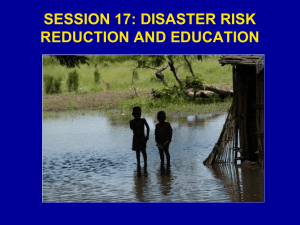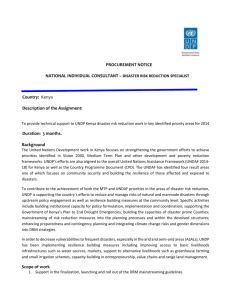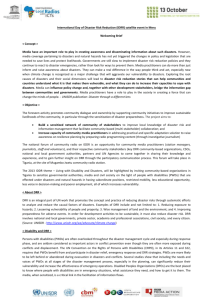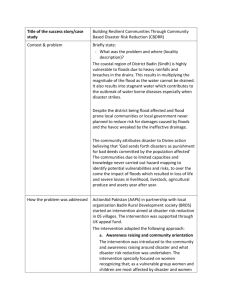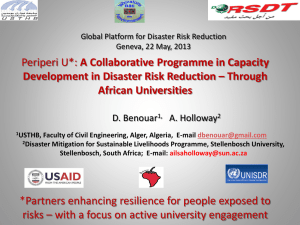Pakistan Country Contribution Mainstreaming Disaster Risk
advertisement
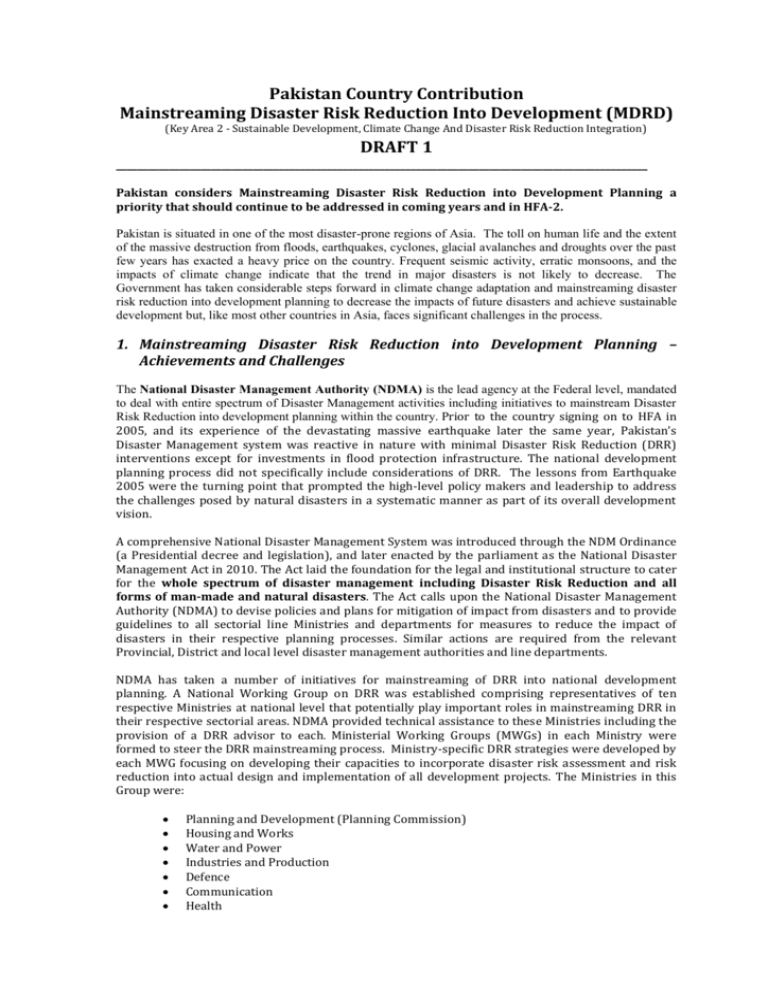
Pakistan Country Contribution Mainstreaming Disaster Risk Reduction Into Development (MDRD) (Key Area 2 - Sustainable Development, Climate Change And Disaster Risk Reduction Integration) DRAFT 1 _____________________________________________________________________________________________________ Pakistan considers Mainstreaming Disaster Risk Reduction into Development Planning a priority that should continue to be addressed in coming years and in HFA-2. Pakistan is situated in one of the most disaster-prone regions of Asia. The toll on human life and the extent of the massive destruction from floods, earthquakes, cyclones, glacial avalanches and droughts over the past few years has exacted a heavy price on the country. Frequent seismic activity, erratic monsoons, and the impacts of climate change indicate that the trend in major disasters is not likely to decrease. The Government has taken considerable steps forward in climate change adaptation and mainstreaming disaster risk reduction into development planning to decrease the impacts of future disasters and achieve sustainable development but, like most other countries in Asia, faces significant challenges in the process. 1. Mainstreaming Disaster Risk Reduction into Development Planning – Achievements and Challenges The National Disaster Management Authority (NDMA) is the lead agency at the Federal level, mandated to deal with entire spectrum of Disaster Management activities including initiatives to mainstream Disaster Risk Reduction into development planning within the country. Prior to the country signing on to HFA in 2005, and its experience of the devastating massive earthquake later the same year, Pakistan’s Disaster Management system was reactive in nature with minimal Disaster Risk Reduction (DRR) interventions except for investments in flood protection infrastructure. The national development planning process did not specifically include considerations of DRR. The lessons from Earthquake 2005 were the turning point that prompted the high-level policy makers and leadership to address the challenges posed by natural disasters in a systematic manner as part of its overall development vision. A comprehensive National Disaster Management System was introduced through the NDM Ordinance (a Presidential decree and legislation), and later enacted by the parliament as the National Disaster Management Act in 2010. The Act laid the foundation for the legal and institutional structure to cater for the whole spectrum of disaster management including Disaster Risk Reduction and all forms of man-made and natural disasters. The Act calls upon the National Disaster Management Authority (NDMA) to devise policies and plans for mitigation of impact from disasters and to provide guidelines to all sectorial line Ministries and departments for measures to reduce the impact of disasters in their respective planning processes. Similar actions are required from the relevant Provincial, District and local level disaster management authorities and line departments. NDMA has taken a number of initiatives for mainstreaming of DRR into national development planning. A National Working Group on DRR was established comprising representatives of ten respective Ministries at national level that potentially play important roles in mainstreaming DRR in their respective sectorial areas. NDMA provided technical assistance to these Ministries including the provision of a DRR advisor to each. Ministerial Working Groups (MWGs) in each Ministry were formed to steer the DRR mainstreaming process. Ministry-specific DRR strategies were developed by each MWG focusing on developing their capacities to incorporate disaster risk assessment and risk reduction into actual design and implementation of all development projects. The Ministries in this Group were: Planning and Development (Planning Commission) Housing and Works Water and Power Industries and Production Defence Communication Health Education Environment Food and Agriculture NDMA helped develop sectorial strategies for mainstreaming DRR into six Ministries. Strategies for four more ministries that formed part of the original group were under formulation when these Ministries were devolved to the Provinces under the 18th Amendment to the Constitution. However, NDMA is now working with the Provinces to create their own DRR Working Groups to continue mainstreaming DRR across sectors. Another milestone achieved for MDRD is the official Notification introducing a DRR checklist as part of official project proforma/ format for all development projects. It is now a condition for any development project to be DRR sensitive if submitted for the approval of the relevant approving forum. The challenge however, is to build capacities for such DRR compliant project formulation, and for scrutiny and analysis. Another major challenge is how to retrofit existing infrastructure DRR resilient bearing in mind the lack of funding for most Government agencies to do this. 2. Climate Change Adaptation (CCA) and Environment For CCA, Pakistan has a robust legal and institutional structure which pre-dates the DRM system. Prior to 18th Amendment to the Constitution of Pakistan in 2011 devolving certain powers to the provinces, there was a national Ministry of Environment with respective Environment Departments in the Provinces. The Environmental Protection Agency of Pakistan was, and remains, the implementing agency at National Level. The environment has continued to be a national development priority and concern for mainstreaming. One of the most important steps taken for mainstreaming CCA and environment protection is that it is mandatory for each development project to have positive Environmental Impact Assessment (EIA). A dedicated Ministry of Climate Change has been established to fulfill international commitments and steer the climate change adaptation measures at national level. The NDMA has been placed under the Ministry of Climate Change. This is likely to help integration of both DRR and CCA, and foster a more coherent approach in the national development process. Currently, the Climate Change Division works directly under the Prime Minister who acts as its Minister In-Charge. This too, is likely to be beneficial in giving higher priority to both CCA and DRR in the national development process and planning. Both DRR and CCA have remained important components of the development planning documents at national level to achieve sustainable development. DRM has been included in the five-year development plans of recent Governments, and, in a recent development vision for Pakistan - Vision 2025 - DRM and CCA were introduced as a separate chapter. The ruling PML-N party has included Disaster Management and CCA in their mandate as top most priorities to address during their term in office. 3. National Disaster Risk Management Framework NDMA, in collaboration with UNDP, developed the National Disaster Risk Management Framework (2007-2012) and identified nine-priority actions for implementation for the initial five years of the Disaster Management System. DRR mainstreaming was one of the nine priority areas. During this period NDMA continued working on the realization of important policies and plans like National Disaster Risk Reduction Policy and the National Disaster Management Plan (NDMP). The National Disaster Management Commission (NDMC), the supreme policy making body on Disaster Management in the country, headed by the Prime Minister, has approved the National Disaster Risk Reduction Policy. Under the policy a 10 Year National Disaster Management Plan (NDMP) has been formulated as Pakistan’s vision and way forward for DRR during next ten years. It 2 has ten identified priority actions in line with HFA and 41 strategies to address these through 118 specific projects and interventions: Establish Institutional and Legal System for disaster management Prepare Disaster Management Plans at various levels Undertake National Hazard and Vulnerability Assessment Establish Multi-hazard Early Warning and Evacuation Systems Promotion of Training, Education and Awareness for DRM Awareness program on Disaster Risk Reduction at local level Infrastructure Development for disaster risk reduction Mainstreaming Disaster Risk Reduction into Development Establish National Emergency Response System Capacity development for Post Disaster Recovery NDMP is to be implemented over a period of 10 years at a total estimated cost of USD one billion. 4. Disaster Impact Assessments Although NDMA is planning to introduce Disaster Impact Assessments, they are not currently part of Environmental Impact Assessments or Social Assessments in the development process. An important challenge though, is that the required capacity for such assessments and DRR mainstreaming needs to be built. Currently the Planning Commission, the approving body for development approvals, finds it extremely difficult to scrutinize and analyze projects in relation to mainstreaming DRR in the development process. Similarly the relevant bodies for proposing and executing these projects lack the capacity to include effective DRR measures in their project proposals. Therefore, all relevant departments need to build capacities of their technical staff to be able to mainstream DRR in their sectors. 5. Barriers to Mainstreaming DRR into Development 5.1. Institutional arrangements Lack of awareness is a primary barrier, as most of the professionals in developments institutions have not yet been fully sensitized on the value and economic benefits of MDRD. The beneficiaries (public) or public representatives who demand such projects are also mostly unaware of the need for MDRD. However, since the creation of NDMA and the DM system at all levels of governance, coupled with the devastating experiences of consecutive mega disasters in past few years, some change is starting to occur in the demand for MDRD. NDMA has been advocating for MDRD with different line ministries and departments and at many forums to raise awareness. It has, in the past, provided DRR mainstreaming advisors to these line ministries and departments, including the Planning Commission, to provide specific advice on MDRD and help them develop sectorial strategies for MDRD. However, capacity remains problematic. It established a National Working Group on DRR comprising ten key ministries, department and sectors, and has also effectively used the National Disaster Management Commission (NDMC) to take important decisions in its recent annual meetings, to ensure implementation at all levels. Importantly, the Chief Ministers of all Provinces and key Ministers at federal level are also NDMC members while the Chairman of NDMA serves as its secretary. Key decisions for MDRD by NDMC are: (i) 2% of overall development budget shall be allocated and reserved specifically for DRR at all levels particularly at district level; and (ii) non- compliance of building codes shall be declared as criminal offence. 5.2. Political Lack of awareness at political level is a key factor as other priorities usually take precedence over MDRD. Also, at times, political expediencies are responsible for non-compliance of MDRD and projects which are not helpful in DRR, or are likely to exacerbate the negative impacts of disasters, sometimes obtain approval due to political reasons. Political pressures have also been identified for allowing illegal encroachments, particularly in waterways and riverbeds. For example, in the province 3 of Sindh, new settlements have materialised in the middle of the Indus River traditional monsoon season passages, known as the ‘Kacha Areas’. These areas are usually dry in other seasons but during monsoon seasons they act as natural passages for floodwater. These new settlements therefore are in the path of floods. In the past few years, new towns have also been developed primarily due to political constituency pressures and public infrastructure including police stations, roads, schools and hospitals have been developed in unsuitable areas. Other factors which contribute to DRR receiving least priority as a development or policy agenda are those considered to be more pressing issues such as the energy crisis, law and order situation, economic development, infrastructure development and other governance issues. 5.3. Legislative Although the National Disaster Management Act, 2010 (earlier a Presidential NDM Ordinance, 2006) has comprehensively catered for the provision of a sound legal regime for DRR in Pakistan, implementation will continue to be hindered in the next few years until such times as institutional strengthening has fully evolved. The hindrances are, again, primarily due to resources constraints and lack of capacities at different levels. Parallel legislation that primarily deals with response and relief, such as the Calamities Act of 1958 and Earthquake Recovery and Rehabilitation Act 2011 creates another challenge. This has resulted in fragmentation of the DM system and duplication of roles and responsibilities. The Emergency Relief Cell at Cabinet Division is also utilizing state resources for relief and recovery while the Earthquake Reconstruction & Rehabilitation Authority (ERRA) is mandated to undertake Recovery and Reconstruction in earthquake affected areas. These institutions sometimes have separate involvement in the implementation of DRR, leading to a lack of coherence in approach. To overcome the confusion and challenges, and in line with the NDM Act 2010, there is a need to establish a regulatory mechanism which sets over-arching standards and guidelines for: (i) all phases of disaster management; (ii) the various sectors; (iii) implementation of building codes; (iv) land use planning and implementation. The 18th Constitutional Amendment has resulted in devolution to the provinces of important subjects and Ministries and departments that could play very important roles in DRR. For example, Ministries of Food and Agriculture, Social Welfare, Environment and Rural Development, Education and Health were abolished at federal level and these ministries had initiated important interventions contributing to DRR. In the absence of these ministries at federal level, NDMA is now constrained by not having important partners to carry on the agenda of DRR. 5.4. Funding Availability of the necessary funding for DRR is a main challenge. The National Disaster Management Fund (NDMF), has been created at the national level and administered by the NDMA. Similar funds are being established at provincial levels although their process is quite slow and mostly are at a nascent stage. The NDMF has, since its inception, been primarily used for provision of relief and has not been effectively utilized for DRR. Although the NDMC has recommended allocation of at least 2% budget for DRR at national, provincial and district level, this has not yet been realized. NDMA has also been pursuing for the allocation of separate budget line for ‘Disaster Management’ in annual budgets at all levels, but it is likely to take more time to have these important funding mechanisms in place. Funding for the implementation of the USD 1 billion 10 Year National Disaster Management Plan (NDMP) - primarily a DRR roadmap for the country is a key challenge. NDMA is pursuing this with Government and donors. 5.5. Capacity Issues The NDM system is still in its formative phase particularly at the local/district level. The capacity to deliver and implement DRR is lacking not only within government organizations, but also NGOs and other development partners which lack trained human resources to carry out this work. As DRR/DRM is relatively a new subject, there is a serious dearth of trained personnel in the country. 4 To overcome some of the capacity and implementation problems, some specific initiatives have been taken. The National Institute of Disaster Management (NIDM) was established to cater for the capacity building requirements at all levels. Also, as part of the NDMP, a comprehensive Communities Based DRM manual and standardized guidelines for instructors in CBDRM, have been developed. NIDM has also initiated organizing short courses for DRM professionals, students, media persons, officials of NGOs and INGOs. Advocacy with political leaders and parliamentarians to sensitize them of needs and requirements of DRM in Pakistan has also been conducted. NDMA, with the assistance of NIDM and Asian Disaster Preparedness Center (ADPC), is organizing training courses for mainstreaming DRR into irrigation sector. This initiative will assist in building the capacities of irrigation sector, one of the most important of all in ensuring DRR against floods. Personnel from disaster management authorities and planning departments at national and provincial levels will also benefit from these trainings and increase the capacity for MDRD. 5.6. Hazard, risk and vulnerability assessments Detailed hazard, risk and vulnerability assessments of the entire country to inform the decisionmaking process on DRR interventions such as safer land-use planning, are still not available. A number of phased initiatives are underway to overcome these barriers. First and foremost is the recently approved National Disaster Risk Reduction policy and National Disaster Management Plan which includes development of Hazard, Risk and Vulnerability Assessments in the priorities. 5.7. Early Warnings Although Pakistan has made substantial achievements in improving early warning systems (EWS), this needs to be further strengthened through the use of innovative technologies and better dissemination of information. Resourcing again is a challenge. 5.8. Advocacy and awareness raising Advocacy and awareness raising projects are being implemented with the support of donors and development partners. The One UN DRM Program (phase-1) was implemented from 2009 to 2012. This was helpful in implementing pilot initiatives in DRM including risk and vulnerability assessments, MDRD, school and hospital safety programs, enhancing response capacities, awareness and Community Based DRM (CBDRM) programs. Currently, consultations and deliberations are under way for the One UN program (phase – II) wherein DRM is one of six strategic priority areas for implementation from 2013 -2017. 5.9. Coordination Various coordination mechanisms have been established at national, provincial and district levels, within the government and with NGOs, INGOs, Donors and UN agencies. These include the National Disaster Management Commission, Provincial Disaster Management Commission, and District Authority/committees, UNCT, and NGOs/INGOs DRR Forum. Such mechanisms are helpful in coordinating joint initiatives, exchanging experiences and lessons learnt, and also to avoid duplication. Coordination between government and donors, and also between donors is considered important to achieve the most effective outcomes in MDRD in Pakistan. JICA and World Bank are strong partners for DRM with the NDMA. Although other large donors such as USAID and DFID have a significant focus on DRM, they are not working closely together or in coordination with the NDMA or government counterparts at all levels. This leads to duplication in some areas and gaps in others, as well as fragmentation of effort. 5.10. Best Practices NDMA is taking steps to capture best practices in Disaster Management and DRR. An extensive Lessons Learned was conducted on the 2010 floods and many recommendations have since been incorporated into disaster management and DRR. Currently, a new project, supported by Oxfam, is 5 being undertaken to capture best practices. These will assist in informing future policies and projects and will be shared with other agencies and countries. 5.11. Private Sector Private sector involvement in DRR is considered another challenge. To date most involvement of the private sector has been in disaster response through Corporate Social Responsibility programs. However, NDMA has begun a process to engage with the private sector to encourage their involvement either by including DRR in their own planning and management processes, or through public-private partnerships, in DRR. 5.12. Complexity of available information on MDRD and CCA Although a lot of literature and information material on MDRD and CCA is available from international sources and experts, it is, firstly, not sufficient keeping in view the challenges and multiplicity of issues being faced in Pakistan. Secondly, it is often written in complex jargon, language and terminology, which can create confusion and does not necessarily translate well. Thirdly, it is frequently not relevant to the needs and does not address indigenous settings and issues. Further, there is a need to have dedicated and specific research relevant to the country’s context and requirements in areas such as: (a) research and studies on the impact of glacial melting in Pakistan; (b) shifting of monsoonal patterns, and the implications; (c) what specific DRR interventions should be prioritized and implemented. 6. Legislation and Regulatory Standards for Public Infrastructure All legislation and regulatory measures have inbuilt mechanisms for implementation. However, there may be issues in the actual implementation of these laws and regulatory mechanisms as they are relatively new and, where there are weaknesses and loopholes, there may be enforcement problems. For instance, the Pakistan Building Codes 1985, updated in 2007, are not being implemented in their letter and spirit because violations are not punishable. Therefore, the National Disaster Management Commission in its first meeting 2007, recommended having a comprehensive legislation and making violations of building codes a criminal offence punishable by law. It should be noted however, that these building codes are only for urban areas and are not yet extended to rural areas. 7. MDRD Implementation at Local Level - CBDRM The institutional structures and capacities for DRR at national level are far stronger than at local level. District Disaster Management Authorities (DDMAs) are weak in most of the districts and non-existent in others. Similarly, capacities of line departments are much weaker at local levels. This is partly because provincial and local level institutions receive fewer resources compared to national. Recently the National and provincial level governments and decision makers have started to focus on capacity building at local level. NDMA’s now has a strong emphasis on building the capacity of DDMA’s. Most donors and implementing partners, including United Nations agencies, have also recently started to address the gaps at local level. MDRD is mostly implemented at local community level with the support of some community-based organizations, NGOs/INGOs and other development partners, as part of their CBDRM programs. One example is FOCUS Humanitarian Assistance which has been implementing a number of CBDRM projects in which all local development initiatives such as construction of community infrastructure including culverts, water channels, schools and other facilities, are constructed with integrating DRR. In the recovery from past disasters such as the 2005 earthquake, Pakistan Floods 2010, 2011 and 2012, all possible efforts were made by Government and other stakeholders to integrate DRR practices in the process at the community level. Shelters and housing solutions, designed for resilience to future disasters and shocks such as avoidance of building in flood prone areas and construction on raised platforms, were provided. Seismic resistant construction was also introduced in 2005 earthquake affected areas. 6 8. Barriers to Successful Local Level Implementation Barriers to implementation of local level DRR practices include funding constraints for DDMA’s, capacity issues. Another which is often overlooked is the comparatively high impact of mega national projects to the detriment of small-scale local DRR practices. For example, if the national agenda or resource constraints are not supportive of creating national flood protection infrastructure, all best efforts at local level for DRR are unlikely to be fruitful as, in the absence of the required dams, small communities can do very little to safeguard themselves in case of major flood events. Capacity is again a major problem. NDMA, PDMAs, donors, UN agencies and NGOs/INGOs are now increasingly focusing on developing capacities at local levels particularly through strengthening the capacities of DDMAs and for communities to implement DRR/ DRM practices. All new projects and programs have strong components of DDMA support and CBDRM activities. The NDMP of Government and ONE UN Program (Phase –II) of UN have been designed to also help bridge the gaps. Strengthening the capacity at local level will remain a critical component of NDMA’s efforts for MDRD. CBDRM will remain important priority in the future and should also be a priority in HFA-2. 9. Monitoring and Evaluation Progress on MDRD has been facilitated and monitored to some extent through NDMA’s National Working Group on mainstreaming DRR but to date, a structured monitoring of projects and development initiatives has not been undertaken. However, most individual projects, whether implemented by government or development partners, have inbuilt monitoring and evaluation mechanisms. It should be noted though, that most of projects are not exclusively DRR projects, but belong to other sectors such as education, health and others, but have DRR integrated within. For example, the Government of Pakistan has implemented exclusive DRR flood protection infrastructure programs in the past. To date, three long term (10 years) National Flood Protection Plans have been implemented while the fourth is in its final stages of formulation. Most of the interventions and projects of Fourth NFP, estimated to cost US$ 566 million, form part of National Disaster Management Plan under which a comprehensive monitoring mechanism is being established at NDMA to monitor progress on implementation of national roadmap in DRR and projects like these. Pakistan has also been reporting regularly through HFA Monitor on its DRR interventions and progress. 10. Trans-border Issues Pakistan lies at the crossroads of Central, West, and South Asia and primarily forms part of South Asia. Its geographic position makes it vulnerable to both natural as well as man-made disasters including complex emergencies. Pakistan shares the Indus Basin with regional neighboring countries particularly India. It is part of traditional monsoon area and the existence of huge glaciers in its north, are factors that make it prone to a number of hydro meteorological disasters. Pakistan has experienced the worst kind of floods in its eastern rivers primarily due to floodwater pressures and subsequent releases by India in these eastern rivers. Being a littoral state of the Arabian Sea (in Indian Ocean) it is also prone to cyclones and tsunamis. Pakistan is also vulnerable to earthquakes as it has a number of active fault lines that could trigger more earthquakes of high magnitude like the one experienced in 2005. All these hazards have trans-boundary implications and this can affect the implementation, or lack of implementation, of DRR. Pakistan has been active in building trans-boundary and international partnerships and linkages to overcome these challenges. It has entered into, or is in the process of concluding a number of cooperative agreements and MoUs, with neighboring countries both at bilateral as well as at multilateral level. It has signed MOUs with Sri Lanka, Turkey and Afghanistan, Kazakhstan, and Kirghizstan. Pakistan has also signed SAARC agreement on rapid response mechanism. 7 The Indus Water Treaty between Pakistan and India is another good working mechanism that should be used for reducing the impact of flood disasters. The success of MDRD by both countries can create a positive impact on trans boundary basis. Pakistan is also Co-Chair of Disaster Management Confidence Building Measure (DM-CBM) of Heart of Asia, Istanbul Process initiative and is contributing positively to implementation of the regional Disaster Management Plan. 11. Other Issues – Man-made Disasters Man-made disasters including conflict and complex emergencies were completely neglected in HFA-1. However, NDMA’s mandate also includes issues related to man-made disasters, and these need to be better addressed in DRR considerations and in HFA-2. 11.1. Industrial Disasters Amongst its initiatives to decrease the risks associated with man-made disasters, Chemical and Industrial Contingency Planning Guidelines are at the final stage of preparation. NDMA is also holding discussions with key industry stakeholders on how best to address the risks from industrial and even nuclear accidents. 11.2. Complex Emergencies Pakistan, like many other countries, has had to deal with complex emergencies within its borders and also the impact on conflict in the region creating immense economic and other shocks to the country. The flow of refugees and displaced persons to urban areas in Pakistan places additional burdens on already fragile environments and infrastructure, and increases urban vulnerability. Further, the risk of disasters in areas affected by insurgencies and complex emergencies poses serious challenges. Many issues related to natural hazards – droughts, scarcity of water, food and other resources – can also contribute to local and regional conflicts. These issues have not yet been considered in detail in the disaster management system. Donors are also highlighting the need to consider these issues in MDRD and building it into their programs particularly in relation to Khyber Pakthunkhwa Province which has seen massive natural disasters in the past few years as well as a complex emergency and the impacts of regional conflict, and also the Federally Administered Tribal Areas (FATA). This is likely to lead to pressure on recipients of funding to include conflict-sensitivity in their DRR programming. The Provincial Government of Khyber Pakthunkhwa is already considering these issues in its future disaster management planning. NDMA is mandated to address man-made disasters, including conflict/complex emergencies, and is already taking steps to include both in future activities. However, this must also be considered in HFA-2 to provide a more realistic and integrated approach to fully integrating DRR. 8



